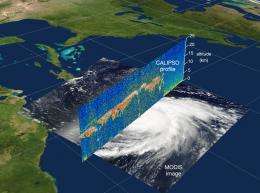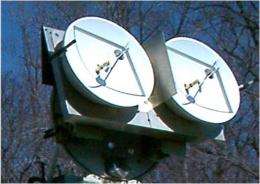Under pressure: Stormy weather sensor for hurricane forecasting

It’s hard to believe that, in this day and age, we don’t have a way to measure sea-level air pressure during hurricanes. NASA researchers, however, are working on a system that will improve forecasting of severe ocean weather by doing just that. The device measures sea-level air pressure, a critical component of hurricane formation – and one that has been extremely difficult to capture.
The Differential Absorption Barometric Radar (DIABAR) prototype is scheduled to make its second flight early this year.
DIABAR remotely senses barometric pressure at sea level, which is important in the prediction and forecasting of severe weather, especially hurricanes, over oceans.
But the ability to measure sea-level air pressure is a major missing link in storm observation, says Dr. Bing Lin, an atmospheric scientist at NASA Langley Research Center in Hampton, Va.
“Air pressure is a driving force of weather systems, especially under severe weather conditions like hurricanes,” he said. “For severe storms, the forecasts of the intensity and track can be significantly improved by pressure measurements.”
A Hurricane’s Life
A hurricane begins as a tropical wave, a westward-moving area of low air pressure. As warm, moist air over the ocean rises in the low air-pressure area, surrounding air replaces it, and circulation forms. This produces strong gusty winds, heavy rain and thunderclouds – a tropical disturbance.

As air pressure drops and winds sustain at 38 mph or more, the disturbance becomes a tropical depression, then a tropical storm, and finally a hurricane with sustained winds of over 73 mph.
Lin hopes eventually to be able to measure sea-level air pressure from aircraft flyovers and space-based satellites. The local coverage provide by flyovers, combined with a broad perspective from space, will provide enough information to significantly improve the ability of forecasters to determine how intense a hurricane is and where it’s headed.
“Large and frequent sea surface measurements are critically needed,” he said. “These measurements cannot be made from buoys and aircraft dropsondes. The only hope is from remote sensing using aircraft, unmanned aerial vehicles, and satellites.”
An effort to remotely sense barometric pressure at sea-surface level using microwaves was undertaken at NASA’s Jet Propulsion Laboratory in Pasadena, Calif., in the 1980s. “JPL has extensive experience on spaceborne microwave sensors,” said Lin.
First Flight
DIABAR was first deployed on a Navy MH-60S helicopter in 2009 at Naval Air Station Patuxent River in Maryland.
“We flew it, got the results, and it looks great,” said Lin.
The next step is testing this year on a blimp called the Bullet Class 580, the world’s largest airship. E-Green Technologies Inc. in Alabama makes the aircraft.
The 235-foot long, 65-foot diameter lighter-than-air vehicle is designed to fly on algae-based biofuel at speeds up to 74 mph and altitudes up to 20,000 feet. It will be stationed in a hanger at Moffett Federal Airfield at NASA Ames Research Center in California.
Provided by JPL/NASA




















